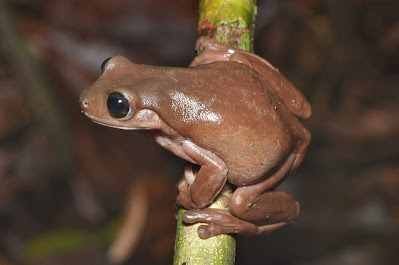 |
| Litoria mira Oliver, Rittmeyer, Torkkola, Dahl, Donnellan & Richards in Oliver, Rittmeyer, Torkkola, ... et Richards, 2020. |
Abstract
Australia and New Guinea (together referred to as Sahul) were linked by land for much of the late Tertiary and share many biotic elements. However, New Guinea is dominated by rainforest, and northern Australia by savannah. Resolving patterns of biotic interchange between these two regions is critical to understanding the expansion and contraction of both habitat types. The green tree frog (Litoria caerulea) has a vast range across northern and eastern Australia and New Guinea. An assessment of mitochondrial and morphological diversity in this nominal taxon in New Guinea reveals two taxa. True Litoria caerulea occurs in disjunct savannahs of the Trans-Fly, Central Province and across northern Australia, with very low genetic divergence, implying late Pleistocene connectivity. A previously unrecognised taxon is endemic to New Guinea and widespread in lowland swampy rainforest. Date estimates for the divergence of the new species suggest Pliocene connectivity across lowland tropical habitats of northern Australia and New Guinea. In contrast, the new species shows shallow phylogeographic structuring across the central mountains of New Guinea, implying recent dispersal between the northern and southern lowlands. These results emphasise that the extent and connectivity of lowland rainforest and savannah environments across northern Australia and southern New Guinea have undergone profound shifts since the late Pliocene.
Keywords: Australian Monsoonal Tropics, biotic exchange, Litoria caerulea, Litoria mira sp. nov., New Guinea, rainforest, Sahul, savannah, Trans-Fly, tree frog.
 |
| Litoria mira holotype (SAMA R70446) from the Purari River Basin in life. Photograph: S. Richards. |
Litoria mira Oliver, Rittmeyer, Torkkola, Dahl, Donnellan & Richards, sp. nov.
Chocolate Tree Frog
Litoria caerulea Tyler (1968 in part)
Litoria caerulea Dahl, Richards & Novotny (2013)
Diagnosis: Litoria mira can be distinguished from all other Litoria by the unique combination of moderately large size (male SUL up to 70.8, female SUL up to 79.6 mm); vomerine teeth present; webbing on hand extending no further than base of penultimate phalanx on fourth finger; limbs without prominent white or yellow lateral folds or ornamentation; lip lacking a white stripe; limbs relatively short and robust (TL/SUL 0.41–0.48); parotoid gland present, but not prominent and not fused with prominent gland on top of head; head relatively narrow (HW/ HL 0.91–1.0), distinctly tapering from body; dorsal colouration uniformly brown, without white or yellow spots; small violet patch of skin at postero-ventral edge of eye; and ventral surfaces of limbs, torso and throat with moderate to extensive regions densely stippled with dark to medium brown.
Etymology: The name mira is the feminine form of the Latin adjective mirum, for surprised or strange, stemming from our surprise in discovering an undescribed member of the predominately Australian L. caerulea group occurring widely across lowland swampy rainforest in New Guinea.
Paul M. Oliver, Eric N. Rittmeyer, Janne Torkkola, Stephen C. Donnellan, Chris Dahl and Stephen J. Richards. 2020. Multiple Trans-Torres Strait Colonisations by Tree Frogs in the Litoria caerulea Group, with the Description of A New Species from New Guinea. Australian Journal of Zoology. 68; 25–39 . DOI: 10.1071/ZO20071
Sweet new discovery – a new species of chocolate frog




